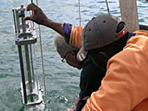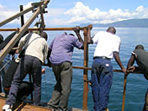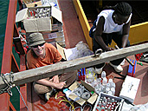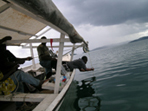Department Surface Waters - Research and Management
Lake Kivu

A fascinating ecosystem and a source of energy
Lake Kivu is situated in East Central Africa and lies on the border of its riparian countries, the Democratic Republic of the Congo and Rwanda. The Lake's surface covers 2385 km2 and its volume amounts to 550 km3 with a maximum depth of 485 m. Its surrounding area offers home to about 2 million people.
Lake Kivu is an amazing and unique aquatic system in several respects. Not only is its water column strongly density stratified, the lake water also contains an estimated amount of 62 km3 of methane and 300 km3 of carbon dioxide. The extraordinarily high concentrations of these gases pose a severe risk to the riparian population in the event of uncontrolled degassing. Such a catastrophic event seems very unlikely under the current conditions, but cannot be completely ruled out in case of an extraordinary event such as a volcanic eruption within the lake. However, the dissolved methane is not only a danger but also a valuable resource.
The involvement of Eawag in research on Lake Kivu has been initiated by the eruption of the volcano Nyiragongo in 2002. Since then, we have conducted several research and consulting projects on Lake Kivu, which are summarized below. The research carried out concerns the unique ecosystem as well as the methane extraction.
The brochure Methane Extraction from Lake Kivu – Scientific background gives a general overview of the important processes that need to be considered when using the methane resources from Lake Kivu. The scientific knowledge on the physics, geochemistry and biology of Lake Kivu has been summarized in the book Lake Kivu - Limnology and biogeochemistry of a tropical great lake.
Results from research projects
Double diffusion

The accumulation of huge amounts of methane and carbon dioxide in Lake Kivu is only possible because density increases strongly with depth below ~60 m. Thus the seasonal convective mixing which happens in most other lakes is inhibited. Upward transport occurs through slow upwelling (< 1 m per year) caused by sub-aquatic inflows, and in part by “double-diffusion”. Investigating upward transport is important for a general understanding of Lake Kivu and in particular for a sustainable extraction of the methane.
Double-diffusion occurs because both temperature and salinity (in Lake Kivu also dissolved gases) are increasing with depth. In regions where the stabilizing gradient of salinity is two to eight times stronger than the destabilizing gradient of temperature, mixed layers (m-scale) form, which are separated by stable interfaces (dm-scale). Investigating the vertical fluxes of temperature, salts and dissolved gases through such double-diffusive staircases is the goal of this project.
Three field campaigns in 2010 (see movie for impressions), 2011 and 2015 have so far been conducted and the main results are:
- We showed that the most common parameterization for vertical fluxes through double-diffusive systems works well for the step sizes observed in Lake Kivu, but underestimates the heat flux in systems with larger steps (like in parts of the Arctic Ocean) by up to a factor of four.
- We conducted direct numerical simulations of double-diffusive interfaces under Lake Kivu conditions and showed that the interface structure is well reproduced by the simulations and that the heat flux through double-diffusive interfaces is close to molecular.
- The results above rely on measuring large gradients within the temperature and salinity interfaces. Even though microstructure sensors are extremely fast (ms) they are not fast enough to accurately resolve double-diffusive interfaces. We therefore developed an in-situ method to improve the current knowledge of the sensor responses.
Publications
Lake sediments and sub-aquatic sources

In the project “Lake Kivu: Learning from the past for managing its future”, we investigated the following topics:
- The lake floor of the northern part of the basin was mapped using a side scan sonar. The resulting map showed old shorelines, which indicated that the lake surface was at least 300 m below its present level about 15’000 years ago. A large number of volcanic structures were observed on the lake floor, which had been formed during or after the lake level rise.
- An analysis of sediment cores indicated a cyclic behaviour of the lake, where long periods of permanent stable stratification were occasionally interrupted by mixing events that were probably caused by volcanic activity. It remains unclear whether these mixing events could also have caused gas eruptions from the lake.
- Several subaquatic groundwater sources feeding the lake were located and the inflowing waters were characterized by sampling at the inflow locations. In agreement with previous predictions from lake modelling, two different types of groundwater sources were found: cool and fresh sources, which are probably fed by rainwater infiltrating in the volcanic ground, and warm and salty sources, which are fed by one or several hydrothermal systems.
- The water balance of the lake was assessed, using a simple modelling approach. The model showed that the observed lake level variations could be largely explained by variations in precipitation. The results also highlighted the lack of recent meteorological and hydrological data from the region.
This project was financed by the Swiss National Science Foundation and the Swiss Agency for Development and Cooperation. The project was done in collaboration with the Institut Supérieur de Bukavu (DR Congo) and the Kigali Institute of Science and Technology (now University of Rwanda). Besides the scientific aims, it also aimed at improving the local research capacities in both countries, the Democratic Republic of the Congo and Rwanda.
This figure is a schematic representation of the subaquatic springs feeding Lake Kivu. Fresher and less saline springs, probably fed by rainwater infiltrating to the north of the lake, enter the lake along its northern shore as indicated by the white discs. Warm saline groundwater springs enter volcanically active region in the norhteastern part of the lake. Their water is denser than the lake water and therefore flows downward following the topography and feeds the deepest part of the lake (Figure from Methane Extraction from Lake Kivu – Scientific background)
Publications
Nutrient cycling and methane production

This project examined the cycles of the main nutrients phosphorus, nitrogen, and silica in Lake Kivu. In particular, the external nutrient sources, their internal fluxes and the export to the sediment were quantified. The study showed that the internal recycling is by far the most important source of the limiting nutrients nitrogen and phosphorus for the biological production in the surface layer of the lake.
Furthermore, the production and consumption of methane in the lake was examined. A previous study had proposed that methane concentrations in the lake may have increased by up to 15% within only 30 years. The present project yielded further indications for increasing methane concentrations.
However, it also showed that the previously estimated 15% increase within 30 years was at the upper end of what could have been supported by the carbon cycling within the lake. An increased upward flux of nutrients due to increased subaquatic groundwater discharge into the lake was estimated to be a possible cause for the increased methane production. However, a follow-up study (see below) then indciated that no significant increase in methane concentrations had occurred since the 1970s.
This project was done in collaboration with the Institut Supérieur de Bukavu (DR Congo) and the National University of Rwanda. It was financed by the Swiss National Science Foundation and the Swiss Agency for Development and Cooperation. Besides the scientific research, it also supported the build-up of research capacities in Rwanda and Congo and provided a continuous scientific exchange. This was an important base for developing the present monitoring of the lake during methane extraction activities by the Lake Kivu Monitoring Program.
Publications
Managing Lake Kivu: moving from a steady-state to a dynamic modelling approach
This project aimed at updating the scientific background for the assessment of different strategies for methane extraction from Lake Kivu.
As part of the project, we adapted the portable field mass-spectrometer recently developed by the Environmental Isotopes research group at Eawag for vertical profiling of gas concentrations in deep lakes. With this instrument, we contributed to an international intercalibration campaign with the aim of updating the concentrations of dissolved methane and carbon dioxide in Lake Kivu. The results showed that there was no significant increase of gas concentrations since the measurements that were performed in the 1970s.
The same instrument was also used to measure a vertical profile of the concentrations of dissolved noble gases and their isotopic composition in the lake. The results showed a a striking lack of atmospheric noble gases as well as a distinct non-atmospheric isotopic signal in the deep waters. The most likely explanation for these observations is that concentrations of atmospheric noble gases are depleted in the groundwater sources feeding the lake.
Finally, we developed a new transient model for Lake Kivu that considers the dynamic properties of the lake and can account for densitiy-driven stratification of the groundwater inflows. For this purpose, we coupled our successful one-dimensional physical lake model Simstrat to the Aquatic EcoDynamics Modelling Library AED2 of the University of Western Australia. The long-term simulations performed with this model showed that the previously postulated and subsequently partially detected groundwater inflows are fully sufficent to allow the emergence of the current density structure of the lake within a time frame of about 2000 years even from a completely mixed lake.
Publications
Methane Harvesting
Management for the safe extraction of methane from Lake Kivu

The Democratic Republic of the Congo and Rwanda decided to reduce the risk of a sudden eruption of the gases dissolved in Lake Kivu. This is intended to be done by extracting the gases from the deep water of the lake and using the methane for power production in a safe, environmentally sustainable, and economically beneficial way. A group of experts, including Eawag representatives, has developed management prescriptions for the safe extraction of methane from Lake Kivu.
A first pilot plant, Kibuye Power 1 (KP1) has started extracting methane from the lake in January 2009. A larger plant with an installed capacity of 26 MW by KivuWatt/ContourGlobal has started operation in December 2015. Several further projects for methane extraction are under development in both countries.
In Rwanda, the Lake Kivu Monitoring Program was established in 2008. It is responsible for monitoring the methane to avoid any impacts on the lake and on the safety of the riparian population. Since 2015, the LKMP is supported by an international expert advisory group with the participation of Eawag representatives. An important next step would be the build-up of a binational authority involving both Rwanda and the DR Congo for the joint management of methane extraction and lake monitoring.
Documents to download:
- Intercalibration campaign for gas concentration measurements in Lake Kivu, Report, 2019, M. Schmid, F. Bärenbold, B. Boehrer, F. Darchambeau, R. Grilli, J. Triest, W. von Tümpling [pdf, 1.74MB]
- Modelling the reinjection of deep-water after methane extraction in Lake Kivu, Report, December 2009, A. Wüest, L. Jarc, M. Schmid [pdf, 2.52MB]
- Management prescriptions for the development of Lake Kivu Gas Resources, Expert Working Group, June 2009 [pdf, 675KB]


